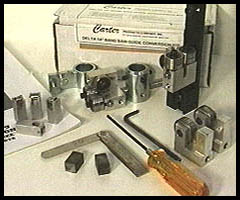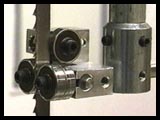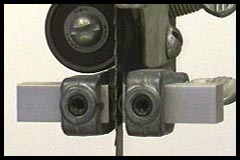

 Tool
Review by Jim Mattson
Tool
Review by Jim Mattson
14"Bandsaw Blade Guides from:
Iturra Design - $58
Carter Products - $149
Johns Manufacturing - $59
I got my first bandsaw, a Rockwell/Delta 14" machine, as a loaner from a friend. He decided he liked drawing furniture better than making it so he farmed out his tools to good homes. The bandsaw came with a carbide-tipped blade which I quickly grew to love. At the time, I never even considered the blade guides for replacement. After all, this was 25 years ago and the issue wasn't nearly as contested.
Later, when I had to give the loaner back, I replaced it with a new Delta 14" which, like the original, came with 1/2" hardened steel blocks for guiding the blade. As my awareness improved and I became more experienced with lesser quality blades, (the only ones I could afford!), it became apparent that maybe upgrading my steel blocks to ball-bearing guides might help me utilize more fully this versatile tool. Fortunately for this review, I never did and I can bring to this examination a fair amount of objectivity.
The Question
Surely there has been a lot of speculation about replacement
bandsaw bearing guides here on the Internet and elsewhere. Usually
this discussion revolves around which guides to purchase and
for what reason. Carter Products has been in the game for a long
time - their ads appeared in the very first issues of Fine Woodworking.
Had the upgrade kit been less expensive for my saw, the temptation
would've been overwhelming.
 Lately, upstart
Louis Iturra has offered a set of bearing guides for far less
money, less installation hassle and you don't abandon the exquisite
guide adjusters (photo at left) which come on the Delta and it's
many clones. He calls them 'Bandrollers'. A third contender comes
from Joe Johns, a member here at the WWA. He sent me a set to
compare to the more widely advertised bearings.
Lately, upstart
Louis Iturra has offered a set of bearing guides for far less
money, less installation hassle and you don't abandon the exquisite
guide adjusters (photo at left) which come on the Delta and it's
many clones. He calls them 'Bandrollers'. A third contender comes
from Joe Johns, a member here at the WWA. He sent me a set to
compare to the more widely advertised bearings.
At first, my inspection focused on which set to pick to help transform my saw into a precision cutting machine, but as I delved deeper, another question arose, 'Do I need these things, anyway?' To be honest, my bandsawing isn't that sophisticated. Mostly my saw sits there close to my workbench collecting more dust than it makes. Early attempts at resawing wide stock left me with the impression this machine just isn't designed for such heavy duties, (especially when a friend has a Makita resaw I can use...:) I did try a 'WoodSlicer' blade from Highland Hardware and it changed my mind a little. Still, with so many other tools in the shop clamoring for attention, it pains me to admit my bandsaw sits idle most of the time.
Mostly my bandsawing is limited to roughing out an ogee foot for a dresser, a handle for a cutting board, a race car for my neighbor's son, a panel blank for a template. Sometimes I'll resaw for a few hours if I can get a few extra pieces from the bandsaw's narrow kerf. Rarely do I ask for a finished cut from this machine and finished cuts are always best when one tries to get projects out the door on schedule! Can adding a set of bearings to your bandsaw give us more frequent finished cuts? Will our blades last longer? Lets find out.
The Carter Guides
 The first thing you wonder
when you attempt to install the Carter guides is: 'Boy, can these
directions get any more puzzling?' Included with the set for
my saw was only one page of instructions. All the pictures on
the page show my machine with the guides attached, blade installed
and the saw table removed. Unfortunately the directions don't
specifically address this and I was wondering do I remove the
table or not?
The first thing you wonder
when you attempt to install the Carter guides is: 'Boy, can these
directions get any more puzzling?' Included with the set for
my saw was only one page of instructions. All the pictures on
the page show my machine with the guides attached, blade installed
and the saw table removed. Unfortunately the directions don't
specifically address this and I was wondering do I remove the
table or not?
Removing the table is no big deal on this machine - remove the two star wheels from below the trunnions and lift it off (after blade is removed). I tried it without removing the table and leaving the blade installed. This worked fine until I got to the lower section (left photo) when I had to remove the blade to slip the lower guides behind it. The two slotted machine screws from the original guides aren't used but are replaced with two Allen-wrench capscrews which seem much more substantial than the original.
 After reinstalling
the blade comes the alignment procedure. Carter suggests adjusting
the top bearings first, then the bottom. I had a problem with
this considering a variable which isn't addressed by the instructions.
Depending on how your tensioned blade sits on a crowned wheel,
it can come off the wheel at a slight angle. Whichever angle
it is isn't important as long as it keeps this angle both top
and bottom - no twist in your blade. Since they suggest a .002"
free-space between the side-bearings and the sawblade, it seemed
important to make sure the blade stays parallel to the bearing
edges.
After reinstalling
the blade comes the alignment procedure. Carter suggests adjusting
the top bearings first, then the bottom. I had a problem with
this considering a variable which isn't addressed by the instructions.
Depending on how your tensioned blade sits on a crowned wheel,
it can come off the wheel at a slight angle. Whichever angle
it is isn't important as long as it keeps this angle both top
and bottom - no twist in your blade. Since they suggest a .002"
free-space between the side-bearings and the sawblade, it seemed
important to make sure the blade stays parallel to the bearing
edges.
The upper guides can adapt to this angle simply by rotating the whole assembly slightly right or left on the saw's guide post. Without anything from the instructions, I mistakenly tried to adjust the bearings parallel to the blade by rotating the assembly slightly off center to the thrust bearing. When the upper assembly was finished, I found out I couldn't do the same for the lower assembly as it isn't adjustable. Instead, I backed off the bearings, re-tracked the blade to adapt more parallel to the lower bearings and then started all over with the top. (Groan)
One more glitch. The whole upper assembly relies on three set-screws to mount to the guide post. A bothersome design fidget is the set-screw directly behind the upper thrust bearing. In order to tighten this screw, the blade needs to be loosened and the bearing assembly removed if you are using a regular Allen wrench (not supplied by Carter). Fortunately I had a ball-end Allen driver (yellow handle - top photo) which let me tighten this screw from an angle. If Carter isn't going to supply such a wrench for their customers, perhaps they could move this screw to another point around the post. Any other point would be better than where it is.
Great Stuff
Without a doubt, the fit and finish of the Carter system is spectacular.
I was very impressed with the bearing quality and the tightness
of machining. Though the assembly may seem delicate - it isn't
and the close tolerances they maintain make adjustments smooth,
if not as simple as the original adjustment system which came
with the saw.
The main advantage is the position of the upper and lower thrust bearings. Unlike the original Delta assembly, which is utilized by the Iturra and Johns bearings, Carter rightly turns their thrust bearing 90 degrees so the back edge of your bandsaw blade is shoved against the curved outer surface of the bearing. This one-point contact, linear to the blade travel, seems far better than having the blade pressed against the bearing face where rotation of the bearing actually rubs across the back of the blade. No matter how you look at this feature, it sets the Carter guides a notch above the other contenders where durability of the blade is concerned. I liked it!
Another durability benefit arises from the shear number of bearings Carter sends you - ten of them, all the same size! If either the upper or lower thrust bearings starts to get sticky, simply swap it out for one of it's under-worked, side-mounted cousins. Little things like this help mitigate the extra cost of the Carter guides and the pain of installation.
The Iturra Guides
 Unlike the Carter guides,
the Bandrollers from Louis Iturra let you keep the great thumb-screw
adjusted mechanism which comes on the Delta 14" bandsaw.
In a matter of minutes, you can swap out the four original steel
blocks and slide back in these baby bearings housed in an aluminum
casing.
Unlike the Carter guides,
the Bandrollers from Louis Iturra let you keep the great thumb-screw
adjusted mechanism which comes on the Delta 14" bandsaw.
In a matter of minutes, you can swap out the four original steel
blocks and slide back in these baby bearings housed in an aluminum
casing.
The Iturra bearings, 3/8" x 3/16" in size, are stacked in pairs on each side and pinned into a milled slot in the aluminum - extremely simple. I had to file the aluminum a bit to get it to slide into the square recesses which housed my steel blocks but this possibility is addressed in the extensive instructions which came with the guides.
And what instructions! Unlike most manuals you get with your tools, Iturra sets a standard for giving their customers as much information as reasonably possible. Some of the issues addressed are blade tracking, wheel alignment, types of blades used for different operations, spring compression, bearing design and they even go one step beyond to suggest you don't use their Bandrollers for saw blades narrower than 1/4" - use Cool Blocks instead. Not only does this guy know bandsaws; he's honest too!
The bearings you get are sealed and are similar to those you might get with a small router bit. Even though they are small and will revolve much faster than the other bearings tested, since a bandsaw blade moves much slower than a high-speed router, figure on Bandrollers lasting a long time. If or when they start to fade, I found it simple to drive the pin out to swap in a new set. No sweat!
The Johns Guides
 Like the guides from Iturra,
the Johns guides exchange with the original blocks from Delta.
From here they divert, only coming for the upper end of your
machine. They also use the largest bearing of the lot and hook
downward from the mounting yoke to reduce your resawing capacity
about 1 1/4". The aluminum supporting the bearings was more
than substantial.
Like the guides from Iturra,
the Johns guides exchange with the original blocks from Delta.
From here they divert, only coming for the upper end of your
machine. They also use the largest bearing of the lot and hook
downward from the mounting yoke to reduce your resawing capacity
about 1 1/4". The aluminum supporting the bearings was more
than substantial.
Like the Carter, the instructions consist of one sheet but the information is concise and accurate. In the instructions, Joe Johns suggests the installation of lower bearings is unnecessary when using a sharp, accurately tensioned bandsaw blade. I agree but we'll look at that later. Unlike Carter and Iturra, he suggests you install the bearings tight to the blade. If your blade protests, due to improper welds or other flights of circumstance, he suggests you buy a better blade. That seemed reasonable.
Another point of departure is the type of bearing used by the others. Instead of the sealed bearings found on the Carter and Iturra guides, Joe opts for a shielded bearing. In my mind this is OK considering how much slower this large bearing rotates compared to the others. Since it's mounted only above, it's out of the sawdust slipstream which can work dust into the bearing causing premature failure. Still, in use these two bearings oozed grease from their innards which partly found it's way onto the blade and into the cut - not good! I would suggest Joe upgrade his bearings a bit if only to prevent this side effect.
Testing and recommendations of this review is concluded on page 2.